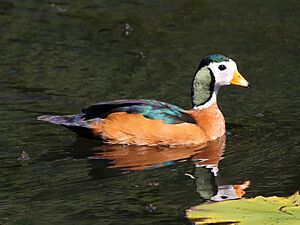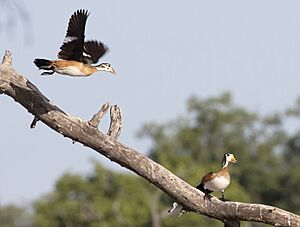African pygmy goose facts for kids
Quick facts for kids African pygmy goose |
|
|---|---|
 |
|
| Male in South Africa | |
| Conservation status | |
| Scientific classification | |
| Genus: |
Nettapus
|
| Species: |
auritus
|
The African pygmy goose (Nettapus auritus) is a very small perching duck found in sub-Saharan Africa. It is the smallest type of waterfowl in Africa. In fact, it's one of the tiniest waterfowl species in the whole world!
Even though it has a beak like a goose, it's actually more closely related to dabbling ducks. This bird is part of an important agreement. This agreement helps protect birds that migrate, or travel, across Africa and Eurasia.
Contents
About Its Name
The African pygmy goose got its scientific name, Nettapus auritus, a long time ago. A Dutch scientist named Pieter Boddaert gave it this name in 1783.
The first part of its name, Nettapus, comes from ancient Greek words. Nētta means "duck" and pous means "foot." People thought this bird had the body and feet of a duck, but the neck of a goose! The second part, auritus, is a Latin word meaning "eared" or "long-eared."
This bird is the only species in its group, which means it's unique!
What It Looks Like
The African pygmy goose is one of the smallest perching ducks. Males usually weigh about 285 grams, and females are a bit lighter at 260 grams. Their wings are about 142 to 165 millimeters long.
They have a short beak that extends up their forehead. This makes them look a little like geese.
Male Pygmy Geese
Male African pygmy geese have a white face with black patches around their eyes. The top of their head is shiny black and goes down the back of their neck. They have cool powder-green patches near their ears.
Their upper neck is white, forming a collar. The bottom of their neck and chest are a light chestnut color. Their sides are a deeper chestnut, and their back is a shiny green. Their tail feathers are black. Their wing feathers are black with shiny green on the top, except for a white stripe on the lower wing feathers. Their belly is white. They have a yellow beak with a black tip and dark gray or black feet. Their eyes are reddish-brown.
Female Pygmy Geese
Female African pygmy geese have a gray face with a dark brown stripe through their eye. They also have smudged brown patches on their cheeks and the back of their neck. Their forehead, the top of their head, and the back of their neck are dark brown with a slight shine.
Their chest and sides are a dark chestnut color. Their back is dark brown. Their wing feathers are dark brown-black, except for a white stripe on the lower wing feathers. Their belly is white. The bottom part of their beak is yellow, and the top part is mottled brown with a dark brown tip. Their feet are dark gray or black.
Baby Pygmy Geese (Ducklings)
Baby African pygmy geese have a white face with black markings. These markings are similar to those on the adult female. They have a dark gray patch around their eye. Their black crown forms a V-shape from their beak to the back of their neck.
Their rump and sides are white, while their back and tail are black. Their neck, chest, and belly are light gray to white. Their wings are black. The bottom part of their beak is pink, and the top part is gray with a light brown tip. Their feet are dark gray or black.
Where It Lives
The African pygmy goose is known to be a nomad. This means it often moves from place to place. You can find it across a large area of sub-Saharan Africa and on the island of Madagascar.
It likes to live in places with slow-moving or still water. These habitats often have lots of water lilies. This includes inland wetlands, open swamps, farm ponds, river pools, and even estuaries (where rivers meet the sea).
What It Eats and How It Lives
The African pygmy goose mainly eats the seeds of water lilies. But it also eats other floating seeds and small insects. Sometimes, it eats other tiny creatures without backbones.
These birds form strong pairs that can stay together for several seasons. They usually start breeding when the rainy season begins. It's quite rare for them to breed successfully when they are kept in zoos or special centers.



